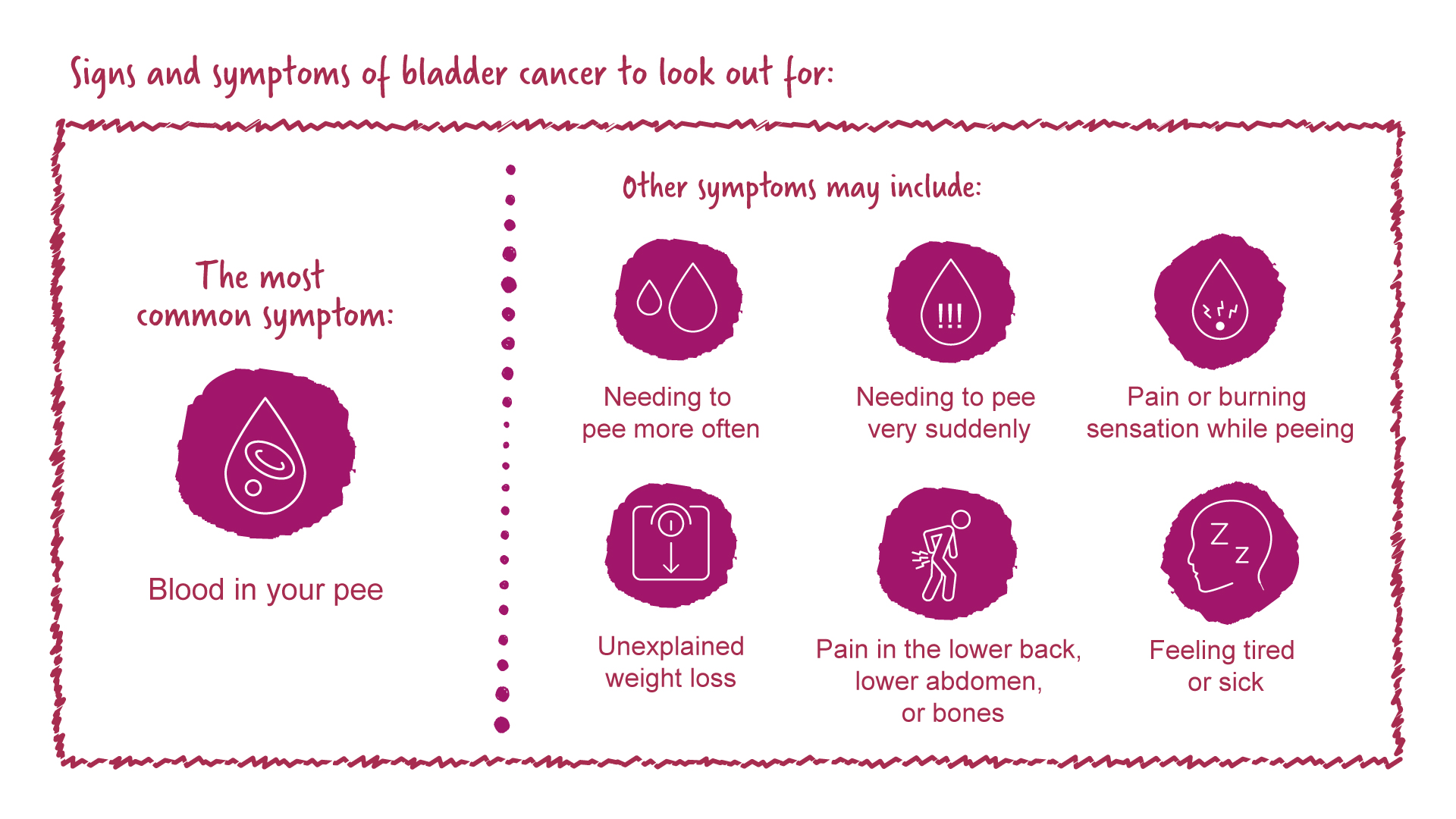What is bladder cancer?
Bladder cancer forms when the healthy cells in the lining of the bladder begin to grow and change in an uncontrolled way.1 Over time, these cells develop into tumours which, in some cases, may spread to other parts of the body.2
The most common type of bladder cancer is called urothelial carcinoma (UC), also known as transitional cell carcinoma.1 About 90% of people diagnosed with bladder cancer have UC, which begins in the urothelial cells that line the inside of the bladder and other parts of the urinary tract.1
Other less common forms of bladder cancer include squamous cell carcinoma, adenocarcinoma, and small-cell bladder cancer. These are caused by other types of cells in the bladder lining.1
Doctors classify bladder cancer using the following descriptions:
- Non-muscle-invasive: Cancer is restricted to the tissue that lines the bladder.3
- Muscle-invasive: Cancer has spread to the muscles that line the bladder, but not beyond the bladder.3
- Advanced or metastatic: Cancer has spread to other parts of the body.3
How many people get bladder cancer, and who is at risk?
Bladder cancer is the tenth-most common cancer in the world.4 In 2020, over 573,000 people were diagnosed and 210,000 people died.3
Bladder cancer is more common in men than in women, and most new diagnoses occur in people aged 75 and older.3 People who smoke are at elevated risk for bladder cancer.3 Other risk factors include exposure to certain chemicals or radiation, having certain medical conditions (such as diabetes, obesity, or certain infections), and a family history with bladder cancer.5 Though these factors may increase the risk of developing bladder cancer, some people who get bladder cancer have no known risk factors.3
What are the signs and symptoms of bladder cancer?
How is bladder cancer diagnosed?
If you experience any of the signs and symptoms of bladder cancer, particularly blood in your pee, you should see a doctor.6 During your appointment, your doctor will perform a series of initial tests. They may perform a clinical examination in which they feel around your abdomen, or you may be asked to provide a urine sample which will be tested for the presence of a urine infection or cancer cells.3,6 It’s also possible that your doctor will do an internal exam, in which they will feel for abnormalities in your bladder.3
Depending on the results of the initial exams, you may need further testing to determine a cancer diagnosis. This may include a cystoscopy, in which your doctor will insert a small, flexible tube into your bladder.4 This allows your doctor to see inside your bladder and take samples (biopsies) from your bladder lining to test for the presence of cancer.3,6
If the biopsy reveals that you do have cancer, you’ll have scans done to determine the size and location of the disease, and whether it has spread.3,6 This is known as staging.3,6 People whose cancer has spread (metastasised) will receive additional testing to understand the best treatment options for their specific disease.3,6
How is bladder cancer treated and managed?
Bladder cancer treatment depends on the stage and type of cancer you have, as well as their personal needs and preferences.3 People with earlier-stage disease are often treated with surgery first, while those with later-stage cancers will receive medicines to shrink and manage the cancer.7
For people with non-muscle-invasive or some muscle-invasive bladder cancers, surgery can remove the affected cells and tissues from the body. This is known as a resection. In some cases, a radical cystectomy (removal of the bladder) will be considered to remove all or part of the bladder.3,6 Surgeons will create a new means of collecting and passing urine for people who have their bladder removed.3
Chemotherapy is a common treatment used to kill cancer cells.3,6 It may be used for patients with non-muscle-invasive, muscle-invasive, or metastatic bladder cancer.3,6 Radiotherapy also kills cancer cells and may be used alone or in combination with chemotherapy treatment.4
People with bladder cancer can also benefit from immune therapies, which use the body’s own immune defences to fight cancer.3,7 Targeted therapies are designed to attack specific biological processes that allow cancer to grow. 3,7
Your doctor can help you decide on the most appropriate treatment course.
I am a carer for someone with bladder cancer. What can I do to support them?
Carers play an important role in supporting people with bladder cancer, but carers need support, too. Astellas interviewed members of bladder cancer patient advocacy groups, and we learned that many carers lack preparation to fully understand what’s to come as they support their loved one through their diagnosis and treatment. This can contribute to feelings of stress.
We created the Bladder Cancer Carer Handbook, which explains what it means to be a carer, how it can feel to take on caring responsibilities, and how carers can look after themselves. You can read the full handbook here:
Feedback from the bladder cancer community
Alex Filicevas, Executive Director of the World Bladder Cancer Patient Coalition (WBCPC), highlights the importance of collaboration to help both patient organizations and industry achieve their goals. WBCPC started partnering with Astellas in 2020, a year after we were established. It has been a fruitful, collaborative relationship, based on trust and mutual respect. The growth and success that we have achieved would not have been possible without the support and commitment of Astellas and our other industry partners.We have been fortunate to partner with Astellas on several projects, including the World Bladder Cancer Patient Forum. Launched in 2021, the second forum allowed us to bring bladder cancer patient advocates from around the world together and Astellas joined the event participating in the panel discussions. This was a great example of collaborative working and I believe that nothing can be achieved to its best by working in silo. It’s through true partnership and collaboration that we will achieve our goals of helping patients. Whilst it can sometimes be difficult to navigate various in-country guidelines and codes of conduct that regulate relationships between patient organizations and pharmaceutical companies, these guidelines are reassuringly bureaucratic and provide both parties the independence and autonomy they need to deliver better outcomes for patients.
The interpersonal relationships that we have fostered with the Astellas team, play an important role in our ongoing partnership. We have been able to build and maintain an environment that allows for open and ongoing feedback and discussions, allowing us to better listen and learn from each other. This bi-directional communication has helped us to identify the needs and obstacles of both sides of the partnership and work together to find solutions.
Looking forward, I would like to see our relationship with Astellas continue to strengthen as we find new ways to collaborate within the patient community and across borders.
Astellas is not affiliated with and does not endorse any specific patient organization. The information provided by Astellas is for informational purposes only and is not meant to replace the advice of a healthcare professional.
Get in touch
Contact [email protected] if you have any questions.
Before you contact us, please take some time to read our Privacy Notice to understand how we process your personal information, and your data protection rights: https://www.astellas.com/eu/privacy-notice-online-resources.
References
- Cancer.Net (ASCO). Bladder Cancer: Introduction. Available from: https://www.cancer.net/cancer-types/bladder-cancer/introduction. Last accessed February 2024.
- WebMd. What is bladder cancer? Available from: https://www.webmd.com/cancer/bladder-cancer/understanding-bladder-cancer-basic-information. Last accessed February 2024.
- ESMO/ACF (2022). Bladder Cancer: Guide for Patients. Available from: https://www.esmo.org/content/download/6589/114929/1/ENBladder-Cancer-Guide-for-Patients.pdf. Last accessed February 2024
- Babjuk, M., et al. “European Association of Urology Guidelines on Non–Muscle-Invasive Bladder Cancer (Ta, T1, and Carcinoma in Situ).” European Urology, vol. 81, no. 1, Jan. 2022, pp. 75–94.
- Cancer Research UK. Risks and causes of bladder cancer. Available from: https://www.cancerresearchuk.org/about-cancer/bladder-cancer/risks-causes. Last accessed February 2024.
- Powles, T., et al. “Bladder cancer: ESMO Clinical Practice Guideline for diagnosis, treatment and follow-up.” Annals of Oncology, vol. 33, no. 3, pp. 244-258.
- Cancer.Net (ASCO). Bladder Cancer: Treatments by stage. Available from: https://www.cancer.net/cancer-types/bladder-cancer/treatments-stage. Last accessed February 2024.

Social Media Information

MAT-GB-NON-2024-00127 March 2024



